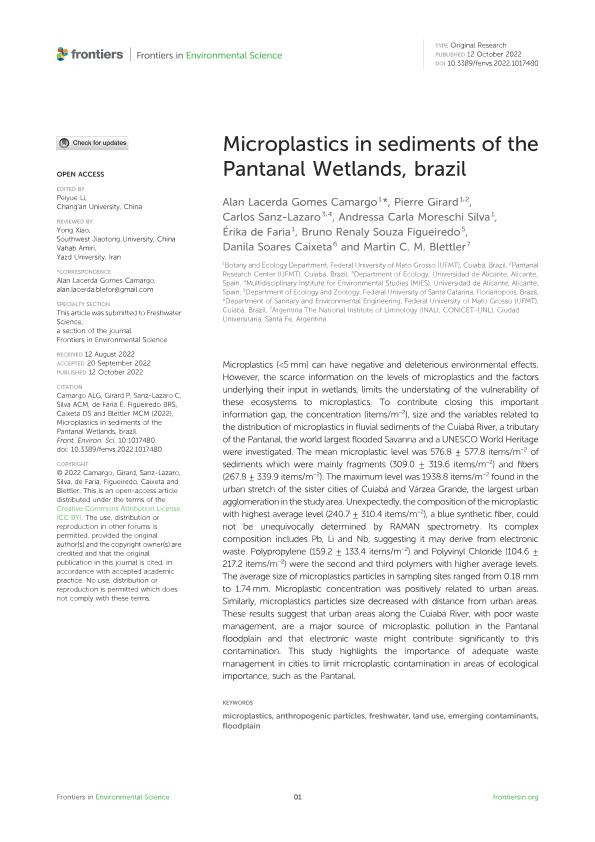Artículo
Microplastics in sediments of the Pantanal Wetlands, Brazil
Camargo, Alan Lacerda Gomes; Girard, Pierre; Sanz Lazaro, Carlos; Moreschi Silva, Andressa Carla; de Faria, Érika; Souza Figueiredo, Bruno Renaly; Caixeta, Danila Soares; Blettler, Martin Cesar Maria

Fecha de publicación:
10/2022
Editorial:
Frontiers Media
Revista:
Frontiers in Environmental Science
e-ISSN:
2296-665X
Idioma:
Inglés
Tipo de recurso:
Artículo publicado
Clasificación temática:
Resumen
Microplastics (<5 mm) can have negative and deleterious environmental effects. However, the scarce information on the levels of microplastics and the factors underlying their input in wetlands, limits the understating of the vulnerability of these ecosystems to microplastics. To contribute closing this important information gap, the concentration (items/m−2), size and the variables related to the distribution of microplastics in fluvial sediments of the Cuiabá River, a tributary of the Pantanal, the world largest flooded Savanna and a UNESCO World Heritage were investigated. The mean microplastic level was 576.8 ± 577.8 items/m−2 of sediments which were mainly fragments (309.0 ± 319.6 items/m−2) and fibers (267.8 ± 339.9 items/m−2). The maximum level was 1938.8 items/m−2 found in the urban stretch of the sister cities of Cuiabá and Várzea Grande, the largest urban agglomeration in the study area. Unexpectedly, the composition of the microplastic with highest average level (240.7 ± 310.4 items/m−2), a blue synthetic fiber, could not be unequivocally determined by RAMAN spectrometry. Its complex composition includes Pb, Li and Nb, suggesting it may derive from electronic waste. Polypropylene (159.2 ± 133.4 items/m−2) and Polyvinyl Chloride (104.6 ± 217.2 items/m−2) were the second and third polymers with higher average levels. The average size of microplastics particles in sampling sites ranged from 0.18 mm to 1.74 mm. Microplastic concentration was positively related to urban areas. Similarly, microplastics particles size decreased with distance from urban areas. These results suggest that urban areas along the Cuiabá River, with poor waste management, are a major source of microplastic pollution in the Pantanal floodplain and that electronic waste might contribute significantly to this contamination. This study highlights the importance of adequate waste management in cities to limit microplastic contamination in areas of ecological importance, such as the Pantanal.
Archivos asociados
Licencia
Identificadores
Colecciones
Articulos(INALI)
Articulos de INST.NAC.DE LIMNOLOGIA (I)
Articulos de INST.NAC.DE LIMNOLOGIA (I)
Citación
Camargo, Alan Lacerda Gomes; Girard, Pierre; Sanz Lazaro, Carlos; Moreschi Silva, Andressa Carla; de Faria, Érika; et al.; Microplastics in sediments of the Pantanal Wetlands, Brazil; Frontiers Media; Frontiers in Environmental Science; 10; 10-2022; 1-12
Compartir
Altmétricas



